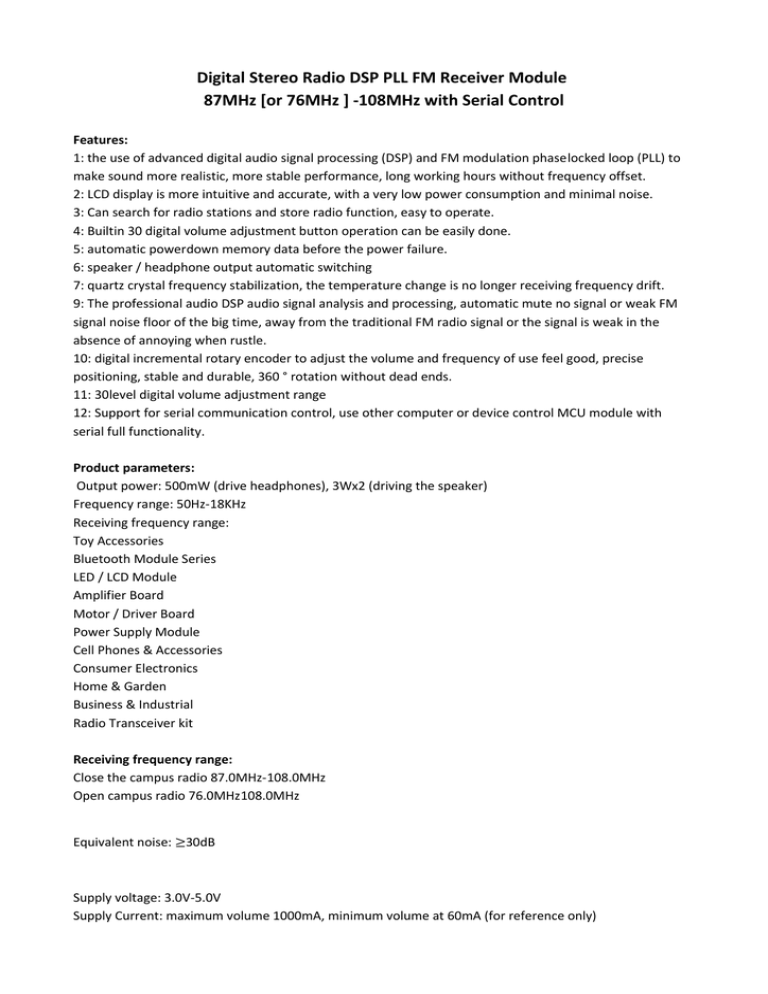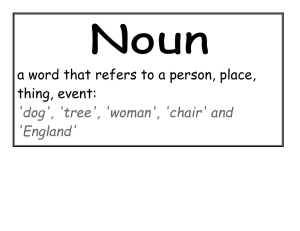Digital Stereo Radio DSP PLL FM Receiver Module 87MHz [or
advertisement

Digital Stereo Radio DSP PLL FM Receiver Module 87MHz [or 76MHz ] -108MHz with Serial Control Features: 1: the use of advanced digital audio signal processing (DSP) and FM modulation phaselocked loop (PLL) to make sound more realistic, more stable performance, long working hours without frequency offset. 2: LCD display is more intuitive and accurate, with a very low power consumption and minimal noise. 3: Can search for radio stations and store radio function, easy to operate. 4: Builtin 30 digital volume adjustment button operation can be easily done. 5: automatic powerdown memory data before the power failure. 6: speaker / headphone output automatic switching 7: quartz crystal frequency stabilization, the temperature change is no longer receiving frequency drift. 9: The professional audio DSP audio signal analysis and processing, automatic mute no signal or weak FM signal noise floor of the big time, away from the traditional FM radio signal or the signal is weak in the absence of annoying when rustle. 10: digital incremental rotary encoder to adjust the volume and frequency of use feel good, precise positioning, stable and durable, 360 ° rotation without dead ends. 11: 30level digital volume adjustment range 12: Support for serial communication control, use other computer or device control MCU module with serial full functionality. Product parameters: Output power: 500mW (drive headphones), 3Wx2 (driving the speaker) Frequency range: 50Hz-18KHz Receiving frequency range: Toy Accessories Bluetooth Module Series LED / LCD Module Amplifier Board Motor / Driver Board Power Supply Module Cell Phones & Accessories Consumer Electronics Home & Garden Business & Industrial Radio Transceiver kit Receiving frequency range: Close the campus radio 87.0MHz-108.0MHz Open campus radio 76.0MHz108.0MHz Equivalent noise: ≥30dB Supply voltage: 3.0V-5.0V Supply Current: maximum volume 1000mA, minimum volume at 60mA (for reference only) Channel: Stereo <1>: Power The corresponding module port (PCB board labeling) - , +, respectively, then the power supply (battery) negative electrode and a positive electrode, a battery or other power source is recommended power supply. You can not use switching power supply without a filter (such as mobile phone chargers, and other switching power supply), or interfere with the power generated will affect the normal operation of the module. This module normal operating voltage of 3.0-5.0V, be careful not to exceed the supply voltage range. <2>: Antenna FM_ANT port used to connect FM antenna for better reception FM signal, we recommend an external 75cm length of the rod antenna. <3>: headphone / speaker output The module comes with 3WX2 channel audio amplifier, speakers To access the speaker ports is recommended 4Ω / 3W speakers. Such as plug in your headphones, audio is automatically switched to the headset channel speaker channels automatically shut down. <4> Volume control Turn the VOL encoder to adjust the volume, while the LCD screen shows the volume series. <5> frequency regulation FRE rotation encoder, receiving frequency, while the LCD screen displays the current frequency down short, encoder handle press to mute / unmute switch. <6> Mute Press VOL knob down mute / unmute <7> Auto mute switch Press down FRE knob turned on or off automatic mute function, LCD display captions ON Enables automatic squelch, OFF means turn off the automatic squelch. <8> Automatic squelch threshold (Threshold) Adjustment (automatic mute switch opens effective) Press FRE knob down, into the automatic squelch threshold adjustment interface, the user can use specific actions to adjust the automatic squelch threshold, adjustment range is 020, the higher the value, the more limited the door, the more likely weak signal Mute. On the contrary the opposite. <9>: access the serial port (not serial control without contact) TTL level serial port module reserve control interface, TTL serial communication module of the need to connect UART_RX, UART_TX and GND Module (PCB corresponding to the location, there is marked), you can use an external MCU (microcontroller) or PC serial port to send commands associated control module Features. Note: Due to computer serial port level is not a TTL level, when connected to a computer connected to RS323 communication required to TTL level electrical switching device paperback or use USB to TTL level serial port module to communicate with the module. Because serial command control module requires some computer expertise, but not buyers please do not try. <10>: User Set This module can be set whether the backlight state to listen to campus radio band, set as follows according to the user's application. Poweroff state long press the VOL knob down electrical power LCD display showing open campus radio C0 C1 represents closed campus radio band, set to take effect after the restart. By setting the backlight state is off state press FRE knob key to turn the display backlight Always indicate B1, B0 denotes a backlight turned off 20 seconds after the restart to take effect. Repeat this step to change the setting to switch the state. The factory is set to not open unified campus radio band, backlight turns off 20 seconds without operation. Note: The factory default setting is Off campus radio, the backlight automatically turns off no operating 20S, Off Auto Squelch. Users set their own depending on the circumstances. This module squelch adjustment method: This module uses DSP digital squelch, the flexibility to use software to control the squelch threshold (threshold). When squelch threshold is 0-20 levels, the lower the number the lower the squelch threshold, the more likely to listen to the radio signal with the background noise, the higher the number, the higher the noise threshold, the output noise is higher than the set value, the automatic static Noise open, so that the output is muted. So when adjusting the squelch threshold, according to the case, if you want to hear the weak signal squelch threshold go down, if you want to hear a strong signal, number to increase. Note that the mute function is not the signal to remove background noise, but the noise level is determined by the signal exceeds the threshold value to control the output muted. Serial demos and configuration: Baud Rate: 38400 TTL level Set the current frequency point: AT <FRE> = 875 Set the current frequency point is 87.5MHZ 760-1080 (open campus radio) 870-1080 (off campus radio) The current frequency or ERR (error) Frequency - 0.1MHZ: AT <FRED> The current frequency point Frequency + 0.1MHZ: AT <FREU> The current frequency point Pause Play / Resume: AT <PAUS> PLAY (Play) PAUS (pause) ERR Set the volume: AT <VOL> = 15 Set the current volume to 15 00-30 VOL value or ERR Volume : AT <VOLD> Volume -1 VOL value or ERR Volume +: AT <VOLU> Volume +1 VOL value or ERR Setting Backlight Off Time (seconds). Where 00 is off 01 long bright: AT <BANK> = 10 Setting the backlight turns off 10 seconds delay 00-99 BANK value or ERR Switch campus radio: AT <CAMPUS> = 1 Open campus radio 0 (off) 1 (open) CAMPUS_OFF or CAMPUS_ON DSP mute switch: AT <SN> = 1 Open squelch function DSP: 0 (off) 1 (open) SN_OFF or SN _ON Set squelch threshold: AT <SN_THR> = 10 Set squelch threshold is 10 00-20 SN_THR value or ERR (SN _ON time before setting a threshold) Reset: AT <CR> reset: 1: VOL = 16 // Volume 16 2: SN_OFF // Close DSP Squelch 3: SNTHR = 10 // recovery squelch threshold is 10 4: FRE = 875 // frequency 87.5MHZ BANK = 20 // backlight turns off delay 20s CAMPOS_OFF // Off campus radio FRE = 875 // current frequency 87.5MHZ OK Returns current status information module: AT <RET> VOL = 10 // Volume 10 FRE = 875 // frequency 87.5MHZ PLAY / PAUS // muted BANK_OFF (BANK_ON) // turns off the backlight time (1 long open, 0 long off, or delays xs) CAMPOS_OFF (CAMPOS_ON) // if open campus radio ZUSÄTZLICHE HINWEISE: * Schnittstellenpegel = TTL (3Vss) * Befehlseingaben ohne Leerstellen; wie z.B. AT<FRE>=893 ( zur Umschaltung auf Frequenz Abschluss der Befehlseingaben mit Zeichen: <CR> 89.3 MHz );
